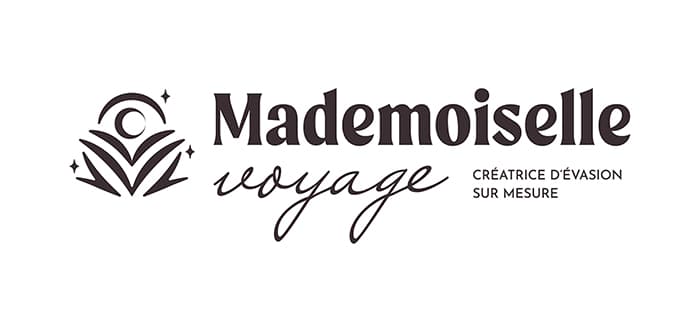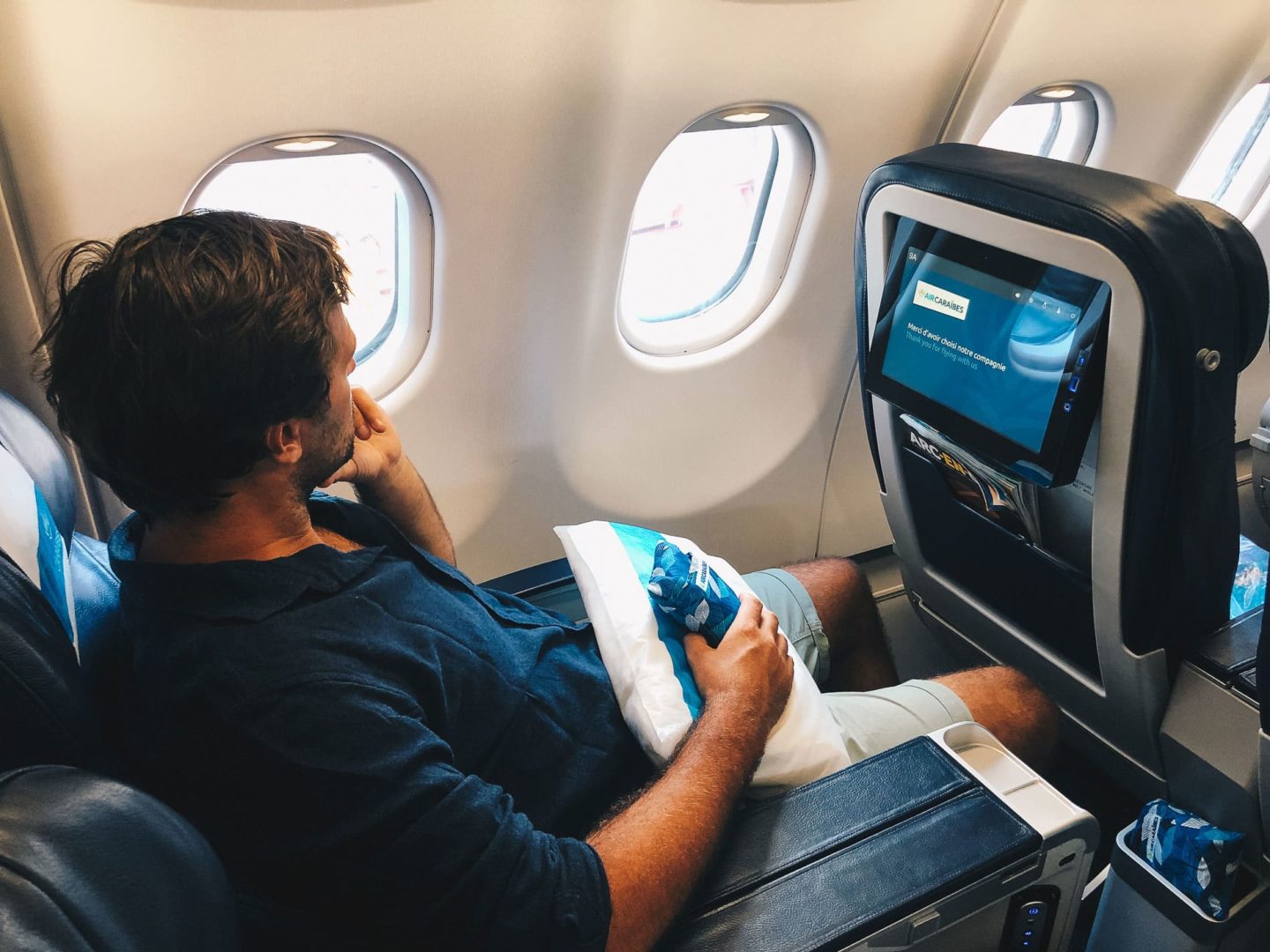
Welcome to Cuba! Before setting off to discover this magnificent destination, we suggest you read this practical guide to help you organize your trip. Cuba is a complex country in terms of organization, especially if you’re looking for an authentic Cuba, far from mass tourism and off the beaten track.
If you’d like to experience the same trip we did, and discover the authenticity of this country, you can send me a request for a quote by email to contact@mademoiselle-voyage.fr. Together, we’ll look at all the different possibilities to ensure that this trip suits you 100% and that you love the country as much as we do, because yes, Cuba was a real “coup de coeur”.
We also invite you to read our other articles on Cuba:
- Baracoa, Cuba’s best-kept secret
- The Viñales and Cayos Levisa and Jutias
- Playa Larga, Playa Giron and Cienaga Zepata
- What to see and do in Cienfuegos
- Trinidad, the colonial pearl and its waterfalls
- Santiago de Cuba, cradle of Cuban identity
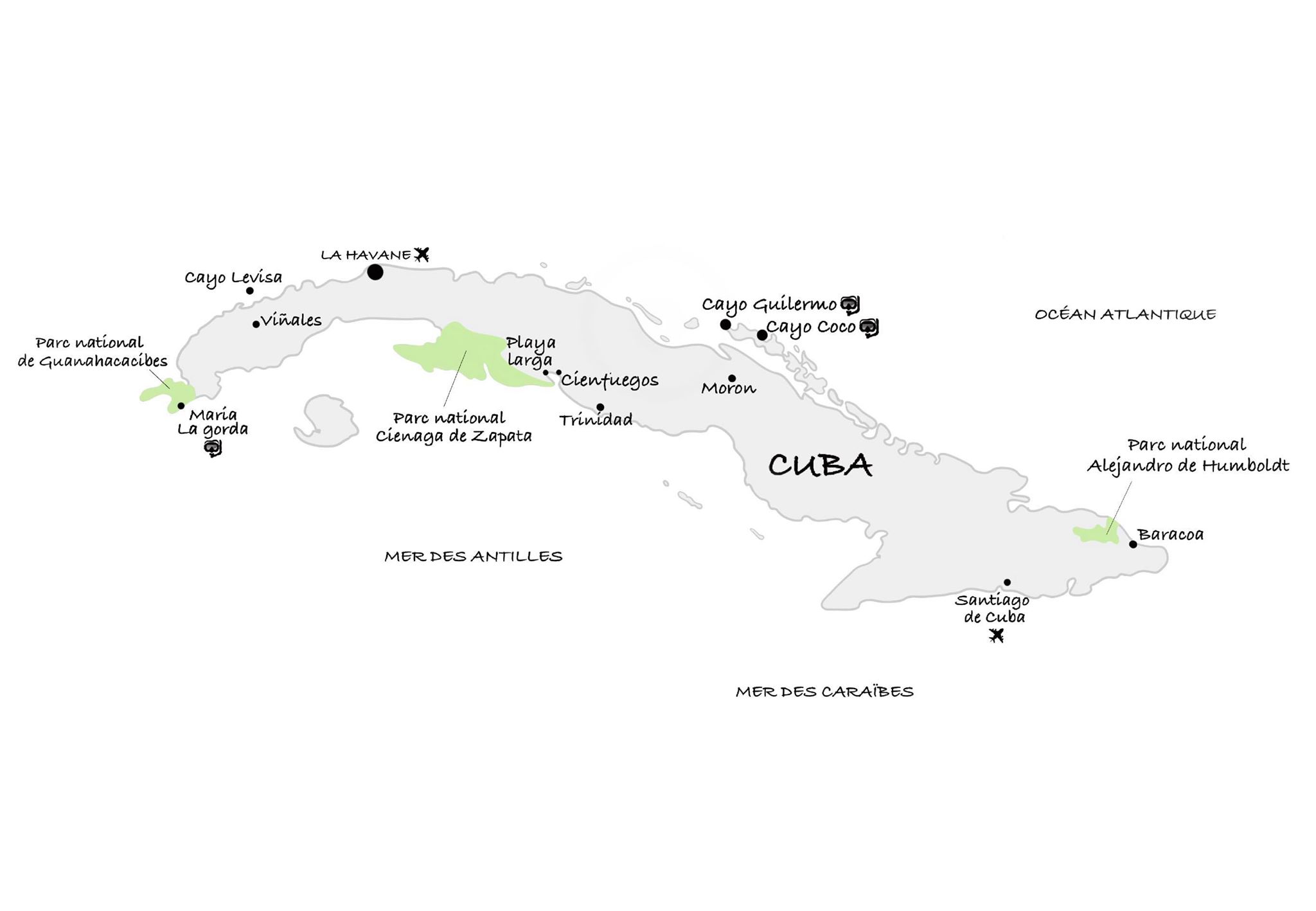
- Time difference
5h to 6h time difference with France, depending on the time of year. When it’s 12pm in Cuba, it’s 6pm in France.
Flying time: approx. 10h outward journey and 9h return journey
- Thefts
For this trip, I tested the services of the company Air Caribbean, an airline I highly recommend for several reasons:
– Modern, spacious aircraft. This is the first time I’ve seen such large screens in economy class (25 cm individual touch-sensitive HD video screen).
– Seat spacing of 81 cm really makes a difference on a long-haul route.
– 120° seat recline
– On-board comfort equipment: power, USB and audio sockets
– Adjustable headrest
– Very pleasant staff on both the outward and return journeys
– Good food
– Wide choice of films
| LOW SEASON | HIGH SEASON | |
| CUBA | 2 weekly return flights. | 4 weekly return flights. |
| LA HAVANE | 1 weekly return flight and 1 flight with a stopover in Santiago on the outward journey, direct on the return. | 3 weekly direct return flights and 1 flight with a stopover in Santiago on the outward journey, direct on the return. |
| SANTIAGO DE CUBA | 1 weekly return flight, direct on the outward journey and with a stopover in Havana on the return. | 1 direct weekly return flight outbound, with a stopover in Havana on the return, except for 2 peak weeks in December. |
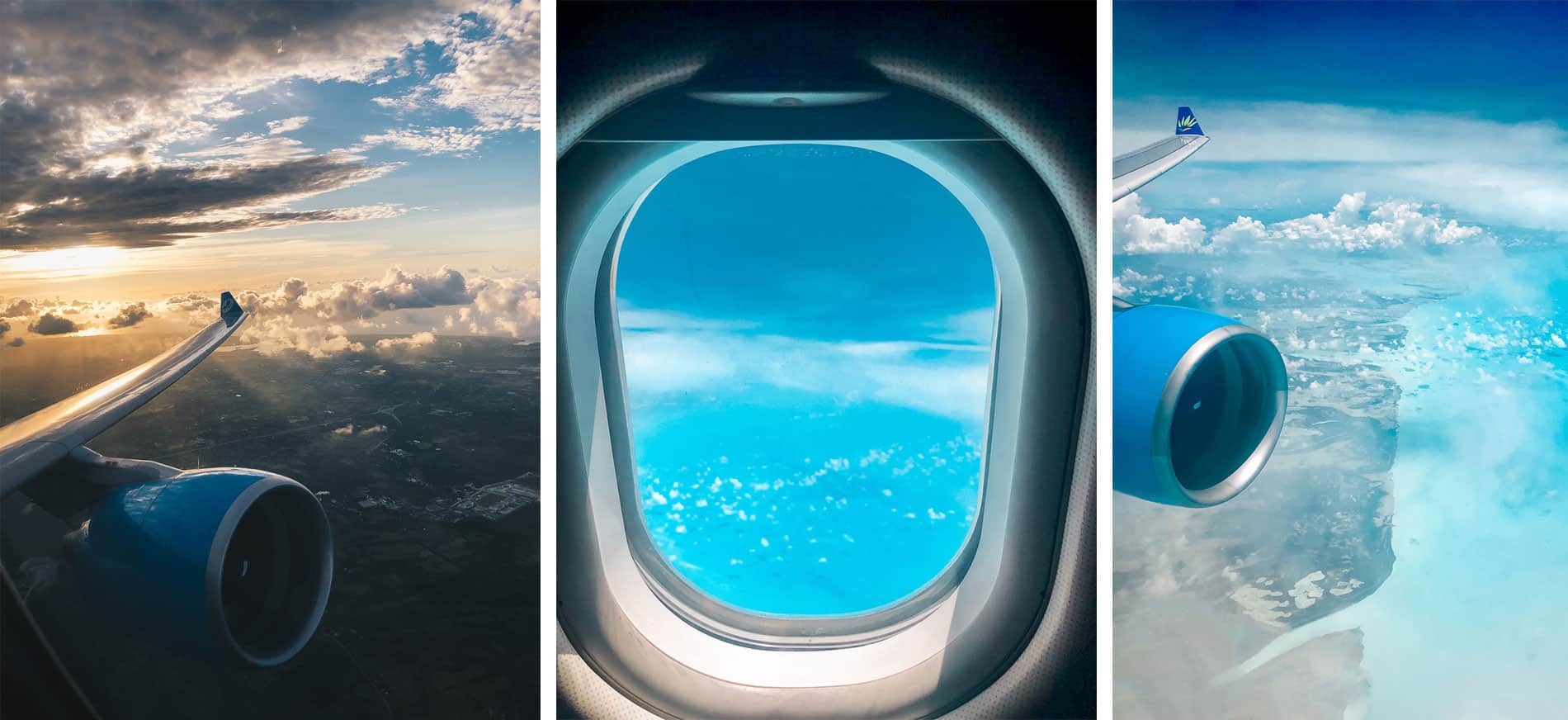
There are 3 classes:
– Sun class (economy)
– the caribbean class (premium economy) we tested.
– madras class (business)
The Caribbean class has a priority boarding and that’s just great! We arrived at Orly 1h15 before check-in and had a dedicated “queue-cutting” check-in counter for rapid passage through police and security control. With children, it’s just a huge time-saver and still a comfort. I loved it on board the iPad mini on loan throughout the flight, to consult a wide selection of magazine titles (Marie Claire, Biba, Paris Match, Le Monde…). You’ll be provided with a comfort kit including a mask for restful relaxation, a pair of socks, a comb, a toothbrush and toothpaste tube, memory foam headphones and earplugs, a blanket and a pillow. Wifi is available as an optional extra.
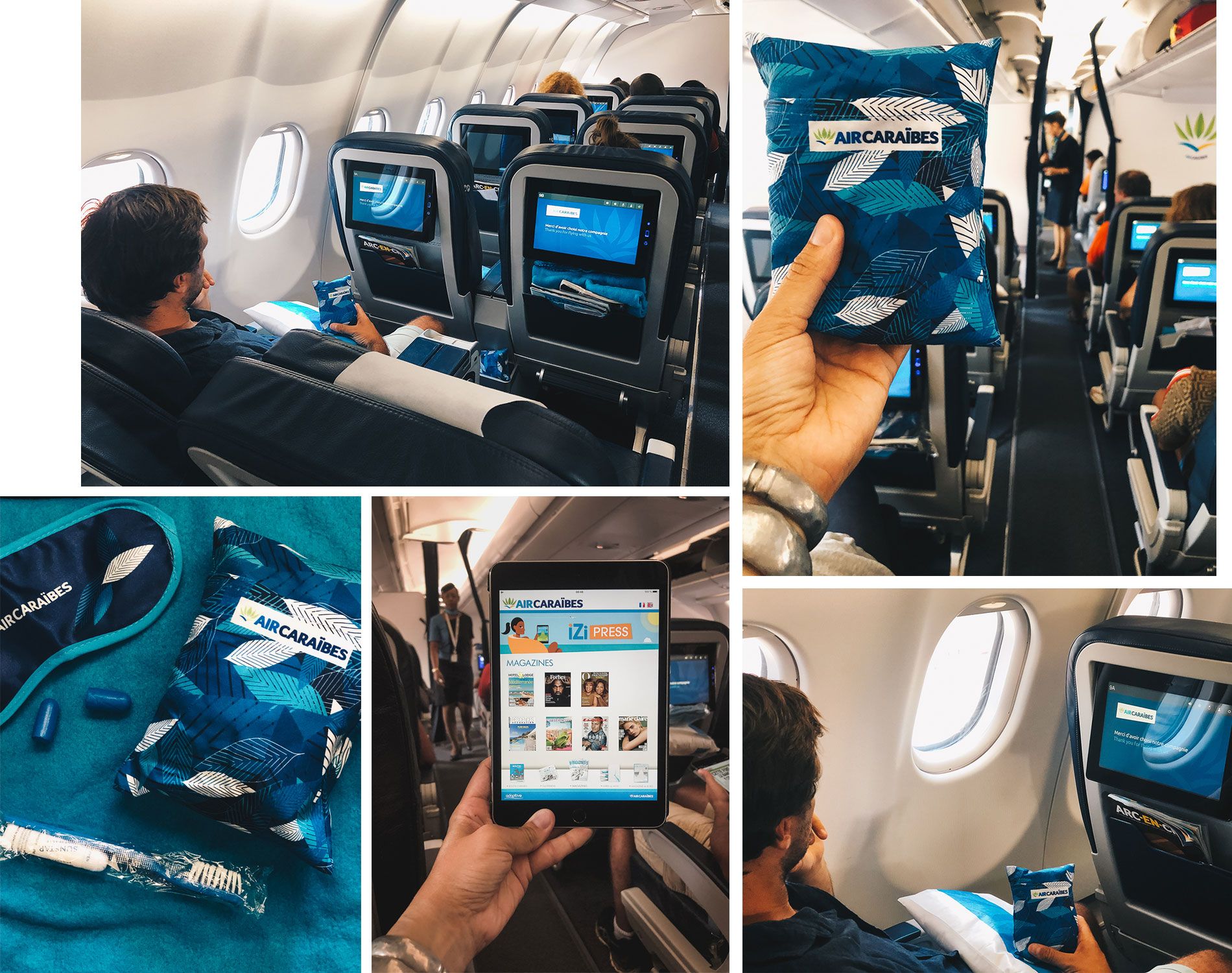
- Air Caraïbes VIP services
– In Sun or Caribbean class, you can enjoy the star dishes of Madras class (Business) for €24 incl. tax/p/passenger. You can purchase it as soon as you buy your plane ticket, up to 48 hours before departure. Go to www.aircaraibes.com
- Good plans Air Caraïbes
Air Caraïbes is also the 1st French airline to connect the provinces and Belgium to the Caribbean from Orly with the eco-mobile solution TGV AIR. The company also offers an air-sea link to the islands of Marie-Galante, Les Saintes and Dominica with navigAIR.
Did you know that by choosing Caribbean class, you are entitled tobunker 2 baggage items weighing 23 kg and 1 cabin bag weighing 12 kg.
- Prohibited items in Cuba
Drones, some GPS units and anything with a satellite in it!
- Currency
The official currency is the CUC and in August 2019, 1€ = 1.07 CUC
You’ll soon realize that 2 currencies circulate in the country: the CUC and the CUP (1 CUC = 25 CUP).
- The CUC, also known as the convertible peso, is the currency most commonly used by tourists.
- The CUP is known as the Cuban peso, and is generally used most frequently by locals. You can buy them and pay for little things with them, such as cigarettes, water and beers, which will cost slightly less… but it’s not compulsory or essential!
Just be careful, because the 2 currencies are very similar, but if you get change in UPC, you’re bound to lose out! Make sure you don’t run out of change and recount (because according to some travelers I’ve met, Cubans can be tricky) and be sure that your CUCs say PESO CONVERTIBLE.
I advise you to do as we did and leave with a large sum of Euros in cash and change them in Havana as soon as you arrive. You can change a part at the airport to pay for your cab, for example, and the office is on the right as you leave the airport. We didn’t make a single withdrawal in Cuba and changed our euros into CUC 2 or 3 times during the trip. It’s better to have more euros than to withdraw with your card, as bank charges are high. Queues at the bank are often long, as in Viñales where I had to spend at least 1 hour between waiting and changing my euros. On the other hand, there’s very little waiting at one of Havana’s exchange offices, in the Havana Vieja district.
- Change
If you’re looking for a Havane to change your euros into CUC quickly and safely, go to the Cadeca Exchange House, near Plaza de San Francisco, off Calle Baratillo.
- Language
The language spoken in Cuba is Spanish. If you master it, it’s just perfect for exchanging, negotiating and discussing. In general, the French are able to make themselves understood, but you should know that Cubans speak very little English, just gibberish. We heard some Cubans speak impeccable German, which was quite impressive!
If you go on guided tours in the big cities, some people speak a little French, so this may come in handy.
We have drivers and guides who speak French so if need be you can call on our services. Please note that we only offer them if you take the trip with us.
- Health
From a health point of view, Cuba is a safe country. Remember to keep your vaccinations up to date: tetanus, polio, diphtheria and hepatitis B.
If you come in August in Cuba (July and August), it is essential to take a mosquito repellent because they won’t miss you! There’s no need to worry about malaria or yellow fever. These mosquitoes are just ferocious at sunrise and sunset. We first met them on the Maria la Gorda and on the western tip in the company of sand flies or fleas, the famous “jejenes” . We didn’t dare leave our room because we were so attacked. Then we ran into them again on the Playa Larga, swamp area. They’re small, but their stings leave pretty marks and make you itch terribly!
One of the best repellents would be Tropic 5/5 black easily found in pharmacies (tell you we didn’t have any product because we had forgotten it!). Take lemongrass and other essential oils to soothe bites. Finally, we recommend you wear loose-fitting, long, light-colored tops and bottoms at sunrise and sunset, and when hiking around Playa Larga. (see related article).
the sun We had to pay the price for this in our first few days in Havana. The result is severe sunburn and peeling skin! Remember to take sun cream and I recommend you with my eyes closed Caudalie suncare range, at textures non-sticky and sunny fragrance of frangipani flowers. I’ve been testing them all month and they’re a real favorite. The products do not contain No alcohol, no silicone, they have safer filters and are free of nanoparticles and octocrylene, suspected endocrine disruptors. Last but not least, the formulas are highly biodegradable for a minimal eco-impact, essential for preserving the marine environment. You can bathe in complete peace of mind.
For you ladies, remember to take sanitary towels or your cup, as they’ll be hard to come by, at least in 2019. I’d also advise you to pack a small first-aid kit with bandages, spasfon, anti-diarrhea, disinfectant and doliprane. You’ll need to take a small stock of medicines with you, as not all products are readily available in Cuba, where there are still supply problems.
If you are sick on site ? Cuba is renowned for having one of the best healthcare systems in the world and for its highly qualified doctors. In fact, a good number of Cuban doctors are in demand in countries such as Brazil and the Dominican Republic. If need be, you can go to a local doctor or to an international clinic. There are a dozen or so in the country’s biggest cities, so don’t worry! Your medical insurance will reimburse you upon your return.
- Water
Cuba’s water is sometimes drinkable, and we drank it on 2 occasions without meaning to. We always recommend that you drink bottled water, especially if you have small intestinal problems. We brushed our teeth with tap water without any problems. Remember to remove the ice cubes if you’re suspicious, but be careful, they’re everywhere. On our side, we had no problems at all.
A word of advice, in view of the shortages the country sometimes faces, when you buy bottles of water on the street, fill up and take several. Some supermarkets are out of stock! Havana Club rum is easier to find than water.
- Toilets
You’re often asked for a small coin at the entrance to the toilets at gas stations, restaurants… Don’t forget to bring tissues, as paper is not always available.
- Entry formalities
– You need a passport valid for the duration of your stay
– To enter Cuba, you’ll need a tourist card, which they call a visa, as soon as you arrive. It can be obtained in several ways either by visiting the Consulate of Cuba in Paris in the 15th arrondissement, or by sending the details by post to the Consulate or to an agency able to do so, at an additional cost (around €25 more per tourist card, or around €47 per person). In these cases, it will be sent to you by post. We can also take care of this for you when you book your trip with us.
If you’re going on your own, you’ll need to have booked your plane tickets in advance, as you’ll be asked for them, and you’ll need to pay 22€/p to the Consulate. All persons must be present to make the tourist card, even if you have babies or children, otherwise you will pay an extra €25 for what is known as a non-personal approach for each absent adult. No scratches are possible, so be careful. The good news is that the tourist card is issued on the spot, so there’s no need to return to the Consulate.
It is valid for 30 days from your arrival on Cuban soil. Don’t lose it, as part of it is withdrawn when you arrive, and the other part when you leave (I gave myself a fright because I couldn’t find it in front of the customs officer!) Without this document, the airline is entitled to deny you boarding.
You can renew your tourist card once, which pushes your trip to the next level 2 months maximum in Cuba. After that, you’ll have to leave the country. If you want to extend your stay even further, the most economical option is to make a return trip to Mexico for a few days.
- Insurance
Before you leave, you must have a medical insurance certificate certifying that you are covered for repatriation and medical expenses abroad. Request it from your insurer or bank. In the event of an inspection, it’s compulsory, but we’ve never been asked. On the other hand, if you’re unlucky enough to be asked for it, the bill can be hefty and more expensive if you take out one of their insurance policies at the airport.
- Airport
Be patient as soon as you arrive in Havana, as there is a long wait at customs. Flights often arrive in the late afternoon or early evening.
- Electric current
110 volts and flat-plug sockets. Universal adapter and multi-socket for charging multiple devices. Hotels and casas have 220V sockets.
- Internet
Cuba doesn’t have 3G, let alone 4G! There are no cybercafés either! So, like everyone else, you’ll have to buy those famous 30-minute, 1-hour, 2-hour or 5-hour cards, depending on what you find. A one-hour session costs 1 CUC.
Once connected to the ETECSA, all you have to do is scratch off the greyed-out fields, i.e. the codes shown on the card, and log in. Be careful to scratch them, only UPC or euro cent coins (1 to 5 cents) work well.
These internet cards can be found just about everywhere: in telecoms centers or Etecsa, but also in stores and hotels. Ask the locals and they’ll tell you where to find them. You can also find them on the black market. Vendors stationed near these centers or wifi points offer them for 2 CUC for a 1-hour card. It’s slightly more expensive but convenient because there’s no waiting.
It’s fairly easy to find them, but sometimes there are shortages, so plan ahead and buy several cards in advance. This will save you time, as you may have to wait a few hours to get them. In Havana, you may be allowed to buy a maximum of 3 per person. We’ve always been lucky and could buy as much as we wanted. 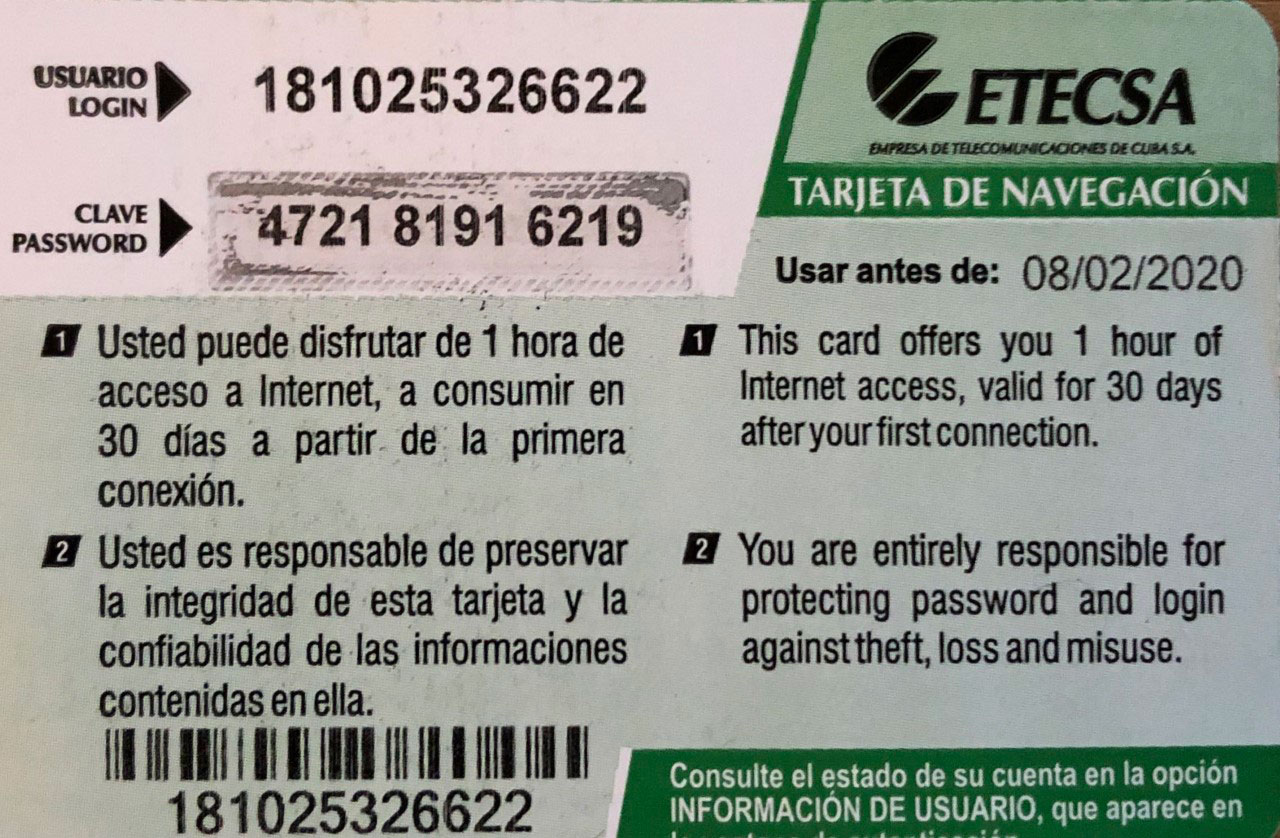
Now that you’re connected, you should know that access is still pretty slow whether you’re in town or in the casas, especially if you want to upload videos. For photos, it’s faster. In the casas, the wifi is private, the owner gives you the key and you can connect with the same card for up to 5 people. When you’re out and about in the city, you’ll see people connected in squares and gardens. Here we capture the wifi public but it’s often very slow and skips! Here, you can only use one card per person. And yes, in Cuba you have to be patient!
Finally, some restaurants (especially in Havana) call out to you by saying free wifi, this signals that they do have wifi and you won’t be using your card. This can be a great way to connect. Please note that some hotels sell internet cards, but you can only use them in the hotel lobby. Be sure to ask whether they’re for use outside or just at home.
Remember to turn off the wifi each time to prevent others from tapping into the network and using up all your credit.
Apart from Trinidad where we had a lot of trouble getting online, we were able to go online every day.
- Phone
In Cuba, you can’t buy a Cuban SIM card to insert in your cell phone. In fact, only Cubans and residents are allowed to open a cell phone line!
However, you can buy a phone card from Etecsa to make nationwide calls to Cuban landlines (no mobiles) from public payphones. And yes, there are still public phone booths that work!
When we needed to call phone numbers to book activities or casas, we would kindly ask the locals to borrow their mobile and offer them 1 CUC for the call. They’ve never accepted money.
casa particular is the accommodation you’re most likely to come across in Cuba. As the name suggests, this means private home or sleep with local people. Basically, the owners live here, and you stay with them in a private room with bathroom. You can spend time in their living room (with family photos on the wall) and in communal areas like the garden or patio. Some casas provide small shower kits, but this will depend on the price of the overnight stay. Bed linen and towels are generally provided.
The rooms in the casas are not always very well insulated, so the windows are not double-glazed and the doors are not very thick. They are often equipped with fans and air conditioning, a safe and a mini bar.
When it comes to accommodation in Cuba, there’s something for everyone, at every price point, depending on what you’re looking for:
- A prize? No worries we find casas particulares in the 10CUC a night in Havana for example or 10CUC in vinales but at that price, you can’t have everything: location, welcome, charm of the casa, noise or a good breakfast. At this price, we’re in mode backpacker but it can be great for smaller budgets. Rooms are not often insulated and you have less privacy. You don’t need to make a reservation, as they’re just about everywhere.
- From charm and authenticity. Casas can be found for around 30 to 40CUC per night with breakfast included throughout the country, with the exception of Havana Vieja, where rates can vary from 90 CUC to 150CUC per night for two with breakfast. Once again, it all depends on your criteria. These casas la are more popular and often need to be booked in advance, depending on the tourist season.
- In the same budget you can find Hostals similar to small hotels, but they don’t have the same charm as a casa, with the welcome and contact that go with it. Sometimes some Casas Hostals are superb and worth a stop, but the owners don’t live there. These are renovated colonial casas with a lot of charm. We found colonial-style casas with beautiful patios, balconies, views, a great welcome, impeccable cleanliness, super copious and very good breakfasts.
- On a large part of the Cayos , most of them are all-inclusive hotels because casas are forbidden and the government controls everything! Here too, you have to look hard, because having tested a few, some of them are a bit old-fashioned, the welcome isn’t great, and the decor of the rooms is old-fashioned, but you don’t have much choice! But don’t worry, I’ve got 2-3 that you’ll like, chosen according to their location and level of service.
- Classic hotels. With the exception of Havana and the Cayos, I wouldn’t opt for this type of accommodation in Cuba, as there’s really no point. Little or no charm, high prices and no contact with the locals. I tested a magnificent hotel in the heart of the Havana Vieja, which I recommend for your first or last night, for example.
To visit Cuba, 4 means of transport are available to you:
- Local transport
Unfortunately in Cuba, you can only take tourist buses from Viazul, often blue state-owned so either the gaviota group or a tourism agency. It is still unfortunately forbidden to travel by local transport, the famous guagua. You can try, but identity cards are often required at the entrance to check whether you are Cuban or not.
Benefits:
– cost (although not cheap and not comparable to Latin American countries)
– it’s always faster than their local transport
– you don’t drive, so you’re less tired
– if you take 5-person vans, you’ll only be able to travel as a family, so it can be akin to private transport.
Disadvantages:
– imposed schedules and frequent delays
– no contact with locals but only with tourists
– no means of stopping anywhere else, such as viewpoints or watchtowers, which is a real shame
– Forced to pick them up at bus terminals or outside the city, as the minivan does not usually pass in front of your casa.
– Depending on the time of year and tourist numbers, the Big drawback: even if there are numerous daily departures, these transports are often full and taken over by other travelers, and you often don’t know this until it’s too late. This can be very restrictive for the organization of your trip, as you may have to wait until the next day or two to leave!
- Group and private cabs
You can make star routes from the major cities, in the cabs, which are old vintage cars, or in Colectivos, small buses. shared. Taking a shared cab can be more convenient, but it often comes at a price, as in Trinidad, where you’ll be asked to pay 30CUC each way to get to the waterfalls (a 40-minute drive). Add to that the cost of admission, and the day can quickly become very expensive!
Beware: cabs generally impose timetables on the spot and don’t wait for you all day. If I take the example of the waterfalls around Trinidad, they usually wait 3 hours. When you know that it already takes you 1h to get down and 1h30 to get back up, you have very little time left on site.
If you can’t find anyone to share your expenses, taking a private cab every day quickly becomes expensive. You’re dependent on cabs and you’ll get less done for sure!
If you choose a shared cab for a journey Havana – > Viñales, about thirty euros/p. For a private cab, the cost will inevitably be higher for the same journey, between €100 and €150.
- Car rental
1. The old American car
We met people who had rented an old American car with luggage on the roof for 6 people for 10 to 15 days. It can be a lot of fun, even if it’s less comfortable than a conventional car, and you’ll have less room for your luggage.
2. The classic car
We rented a car Peugeot 301 for our entire trip of 21 days and we have absolutely no regrets, because for us it was the best way to discover the country and have total freedom!
We only found benefits as:
– the freedom to leave whenever you wanted
– access to watchtowers at sunrise and sunset
– go to less touristy places
– eat in out-of-town restaurants with different views
– to find charming casas on hilltops with breathtaking views.
– to stop off in the tourist-free coves of Playa larga
– If the weather is bad, you can adjust your day with the car and let the storm pass!
I think a car in Cuba is essential if you want a trip off the beaten track and don’t want to end up with everyone else.
Disadvantages:
The big disadvantage is the higher cost, which can easily range from 70€ to 120€ per day, depending on availability and time of year. To this we add petrol, daily insurance (15 CUC on average), the cost of an additional driver (30 CUC), abandonment costs if you return the car in another place, and fatigue, as the journeys can be long (6-7 hours on the road) and require concentration on certain stretches. If there are 4 of you, it’s cheaper and you can take turns.
It is also important to pay attention to the surbooking when you know that Cuba has very few rental cars. Agencies sell you cars, but when you arrive, you realize that the car is not available. You can wait 1 or several days before picking it up and wait a few hours in their office once you’re there! And yes, this is Cuba, and you have to be patient!
For our part, we had a partner of choice, very serious and professional, with whom we work for our tour packages to Cuba. The car was picked up in 15 minutes on the clock (which surprised many Cubans who had warned me about the overbooking) and returned to another airport in a few minutes too.
- Car parking
We belatedly heard that cars had to be left in secure parking lots at night to avoid breakage and theft. Our cars are easy to spot because Cubans don’t rent cars, and all rental cars look the same – they’re usually gray station wagons. Most of these parking lots are in the city, and look more like gated garden areas rented by locals than the real parking lots we’re used to seeing.
We met 2 Frenchwomen who did it every night and had a parking budget for it. As for us, we’ve never done it. We were very well looked after, the hosts of our casas were often recommended and known in the neighborhood, so we felt safe and didn’t even question it.
- Parking lots in general
Whether it’s by the sea, in front of a restaurant, under a tree, or a little out of the way, you’ll have to pay for parking at almost every stop. There’s always someone who appears out of nowhere to ask you to pay 1 or 2 CUC to watch the car. No matter how annoyed or displeased you may be, you don’t have much choice because there’s nowhere else to park the car! These jobs are often held by retirees or young people to supplement their income.
3. Road conditions and petrol
On classic routes Havana – Viñales – Trinidad, roads are fine, but in the rest of the country, theroads are often “rotten” and broken (potholes can sometimes be very large, pavements regularly deformed, roads bulging… ). So you’ll need to know how to drive on these roads frequented by bikes, horse-drawn carriages, pedestrians crossing highways, buses, trucks, roadside vendors, horseback riders, tractors and oxen, all at the same time! You’ll see, it’s very folkloric! But don’t worry, when you use our services, we’ll point out any hazards you may encounter at certain times. Everything will be detailed in the travel log.
Another important detail: cubans don’t know how to drive and overtake at any time!
When traveling to Cuba, it is important to plan ahead for gasoline because in August 2019, there were shortages at some stations and it happened several times that we couldn’t find any right away!
In Cuba, we don’t drive at night and we try to be home by the end of the day, as the roads are not lit.
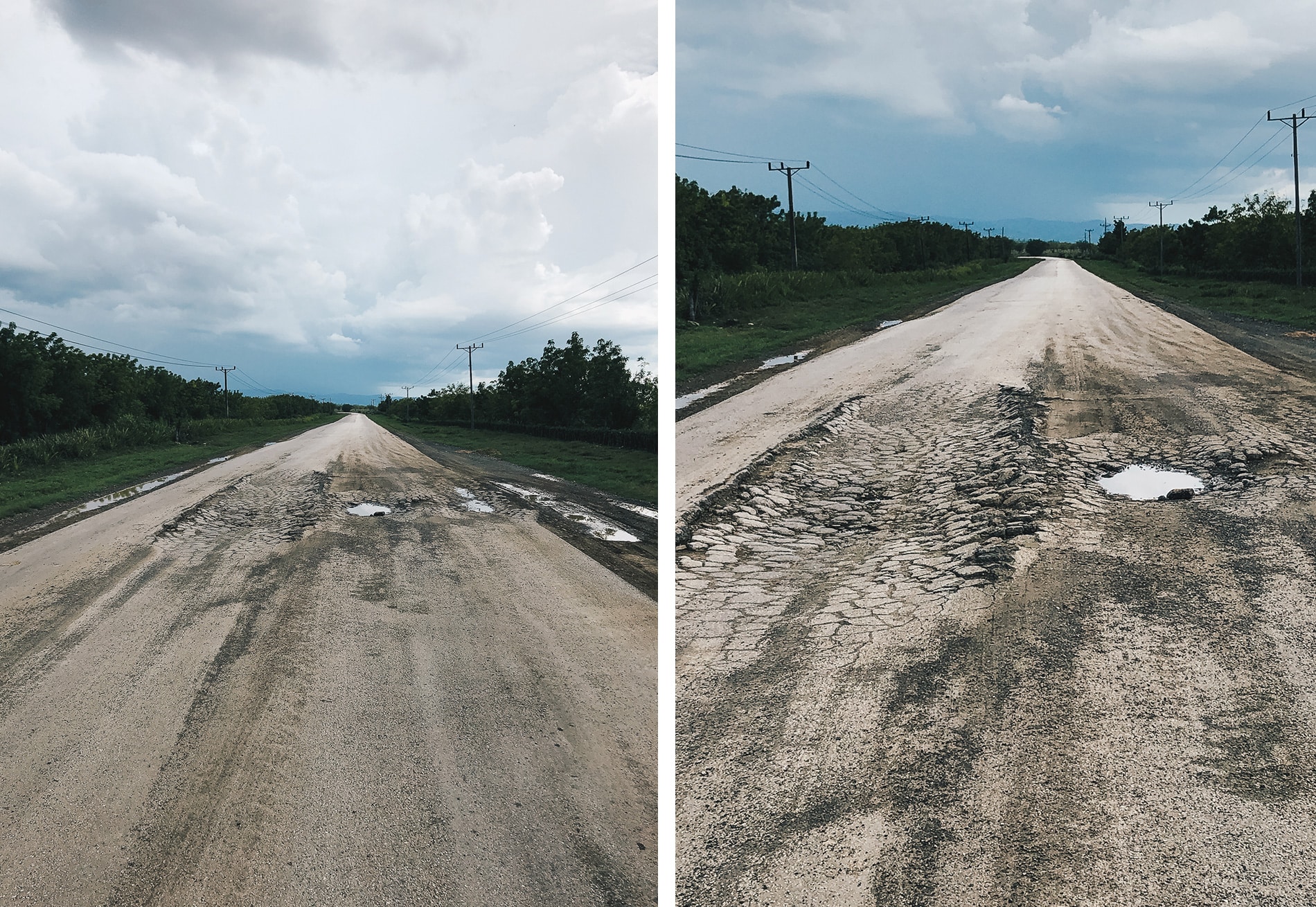
- Car rental with driver
It’s also possible to rent a chauffeur-driven car, and that’s just perfect for you, because you don’t have the constraints but all the advantages of owning a car. You’ll need to bear in mind that the driver will be with you all the way, and the cost will include his board and lodging.
Having a driver allows you to talk with him about the country’s history, how it works, its customs… and can be very enriching for this type of trip. The driver will also give you tips on restaurants and nice places to stop. The fact that he speaks Spanish (some speak a little French or English) is a big plus for your trip, as you won’t have much to deal with and he’ll be able to handle any situation.
If you wish, we can provide you with friendly guided drivers who speak a little French and will take good care of you.
A Cuba, we often eat the same thing. You’ll always find pretty much the same dishes in restaurants: chicken, pork, beef, fish and shrimp, often cooked in the same way and with the same sauces. It’s good, but after 1 month of travel, I was beginning to tire of it!
The side dishes are often rice tostones (fried bananas), the viandas fritas (banana chips), what they call the verdura, a few sliced cucumbers with cabbage and a little tomato (when available).
On the Playa larga, you can taste crab and lobster for example, at very affordable prices between 8CUC and 12 CUC/p. The plates are very generous and plentiful, and we sometimes ordered a dish with garnishes, which we shared.
The fruits you’ll encounter most are: guava, watermelon, mango, papaya, and bananas. These are often the fruits served at the breakfast table. We sometimes have pineapple and passion fruit from the Baracoa coast. There are far fewer fruit stands than in Latin America in general.
In August 2019, we were in an economic crisis and sometimes there were no certain foods like olive oil or tomatoes.
- Cost per person
Expect to pay between 8 and 12 CUC for a dish.
1.50CUC to 2 CUC for beer and water
2.50 CUC to 3 CUC for cocktails (depending on location)
Lobster between 12 and 30 CUC
Shrimps around 12 CUC
Fish fillet from 6 to 10 CUC
Pork chicken beef 6 to 10 CUC
For meat lovers, don’t miss the Ropa vieja made with bourguignon-style beef. In Vinales and Trinidad, the ropa vieja is very good. In Viñales, you must also try the with their succulent grills.
On the Havana side: we tasted a very good ceviche and drank the best daiquiris. Mojitos are very disappointing because they are made with still water and are often loaded with sugar.
In Trinidad, don’t leave without trying the cocktail Canchachara
We found a variety of dishes to Havana and above all to Trinidad and Baracoa which makes it possible to indulge more and vary dishes.
Cuba is a country where we felt safe all the time and at any hour of the night! As always, there is no such thing as 0 risk, so be vigilant and follow the basic rules when traveling (don’t walk around with valuables, keep an eye on your personal belongings, avoid ostentatious signs of wealth…) because yes, there can be snatch thefts in big cities. As an anecdote, we met a French woman who had forgotten her cell phone in a Havana tourist bar and returned to the same place a few hours later. The bartender kept his phone for him!
Cubans are on the whole very kind, smiling, respectful, no inappropriate words or looks, no violence or insults. Men are quite flirtatious in the street and can compliment you easily even if you’re with your husband. It’s not unpleasant.
Cubans are unarmed, and you should know that here in Cuba, locals risk a lot if they’re caught stealing: it’s direct imprisonment for several years, and we’re talking about a 10m2 cell with 20 people in it in worse conditions than in France.
After all, Cuba remains one of the safest countries in the world!
We encountered some scams but as we were often with locals, we were able to avoid them!
- One of the first we came across was the fake policeman. In the back of the car, we took along some locals from Pinar del Rio and a little further south. Here, people dressed as fake policemen wait at the side of the freeway. They whistle at you from afar and ask you to stop. We thought it was a routine checkpoint, but luckily the locals shouted at us in Spanish not to stop and carry on. There was no physical risk, but they could have asked us to pay money and a fine for allegedly exceeding the speed limit, in order to reserve a room in one of their casas…. the technique is not to stop. In any case, a real policeman will quickly get on his motorcycle or car to follow you.
- The second scam is thescam of rabatteurs. We met him in Trinidad. Once again, we had a local with us, but the first time we were alone. Once back in the city, young people shout at the window to tell you that the central square is closed, so all access around it and you have to turn around. Stupidly, you stop, open the window to see what’s going on, and the young man in question is nothing more than a hustler trying to dissuade you from going to your casa. He has a much better, open casa to offer you. He even wants to take you there. Don’t fall for it, and don’t tell him where you’re staying either, because he can easily find you. We were always covering our tracks!
- The third scam encountered at the Havane and in big cities, it’s the technique of: I need 5 CUC to buy a bottle of milk for my child or I’m collecting euros, do you have a coin for me? ? At first, we didn’t really know what to think, given the situation in the country and the shortages we encountered, i.e. little or no fuel, no eggs, no chicken, no oil at certain times…. But fortunately we were well supported by my contacts to avoid these little traps that make you feel uncomfortable. The good news is that they’re not pushy, and when you tell them no, it’s no, and they leave without following you!
- We’ve also met charming people on the street who ask you: De qué pais son ? which means what country are you from? Basically, it’s very nice, but you strike up a conversation with them and it’s a way of offering you all their services, cabs, restaurants, casas and even a guide for the day. You’ll get this question dozens of times a day! We met a very nice person like that on the 1st day in Havana. Without asking us anything, she wanted to show us a beautiful terrace (which was quite true) that was right next door and then give us some explanations about the city… but in the end, we just wanted to be nice and answer her question about where we were from? She probably expected financial compensation! Next time, say you’re from Slovakia or Bulgaria (they don’t know how to speak these languages and will leave you alone more easily if you don’t speak the language).
- Other scams include the punctured tires to make you buy new ones at full price, the sale of doctored cigars (cut with banana or palm leaves), the increase in cab fares from 1 CUC to 10 or 15 CUC for a 10-minute ride.
- Pedestrians don’t have priority in Cuba, and this was clearly felt in the cities. A car will hardly stop to let you pass, it’s mind-boggling. You’ll be honked at to let you know they’re passing, but be careful.
In August 2019, it was particularly hot, between 34 degrees and 38 degrees. We had a lot of ssunshine, a few cloudy spells and 3 or 4 heavy tropical showers lasting around 1/2 hour.
Remember to pack light, loose-fitting, long clothing to avoid mosquitoes, but also to withstand the heat and humidity. Don’t forget theYou’ll also need a small pocket umbrella to tide you over for short trips, good walking shoes for hikes, and shoes for walking in water. They’ll come in handy in waterfalls, on rocks in creeks, in rivers… pretty handy we’ve found!
Finally, you can have your clothes washed in the casas particulières. We have done so on 2 occasions.
We strongly advise you to pack clothes you no longer like, for example, or those that are too small (such as children’s or babies’ clothes), or that you would like to donate to charities. Why? because Cuban women can’t afford to buy clothes, perfumes, soaps, creams… when you know that the average salary in 2019 is $10 a month, you understand their demands better. So get your sample bags from Sephora and get rid of your stuff on the spot. Cuban women are very coquettish and will appreciate this gesture. You can give them a tip in a casa or on the street if you meet someone you like.
You’ll see, women won’t hesitate to come up to you and ask you to swap your T-shirt, a beach towel or perfume for mangoes or something else.
Cuba is undoubtedly a great destination for indulging yourself and bringing back plenty of souvenirs. Something for every taste and budget
- Havana (unique and beautiful paintings starting at $20)
- Cigars in Viñales
- Pottery and embroidery in Trinidad and the Valle de los Indigenios.
- Very good rum in Santiago de Cuba
- Coffee, cocoa, coconut oil and aloe vera from Baracoa
- Babioles, hats, bags, maracas, instruments and trinkets all over the country
The country can be visited all year round. We were there in August 2019, which is a good time because it’s hot, but it’s also the vacation season for many Europeans. We’ve had a particularly hot year, as there hasn’t been any rain since February 2019! Temperatures fluctuated daily between 34 degrees and 38 degrees. Add to this the humidity factor of around 90% to 100% and you get very sunny days and a few tropical showers to cool the atmosphere (we must have had 3 or 4 showers over 1 month of travel, often on transfers, so nothing disruptive). Although they’re strong, they don’t last long.
If you can’t stand the heat, you should definitely avoid the very hot months of July and August.
However, Cuba has 2 seasons:
- November to April is the dry season. In short, it’s raining less but it’s cooler in the evening. Expect daytime temperatures of between 18 and 20°C, with maximum temperatures of between 26 and 29°C. The average water temperature is 24°C. Beaches can be windier during these months.
This is also the peak season for Cuba, as many travelers want to get away from it all during the Christmas and winter periods.
- From May to October, it’s the rainy season. but nothing like the monsoon in India! Cuba’s rains won’t prevent you from enjoying your stay to the full. So it’s warmer during these months, 32°C on average, and there are often heavy rain but of short duration at the end of the day. The sea is the warmest, with water temperatures of around 30°C. The water was so hot on Cayo Levisa that we went in every 15 minutes to dry off!
The months most prone to hurricanes remain September and October, and the most recent was Hurricane Matthew in 2017, which hit the eastern part of the island near Baracoa particularly hard, with no fatalities. Please note that these are just possibilities, and you are often warned early enough by the media to be on the safe side.
- Budget
Cuba is not a cheap destination like Asian countries. There’s a huge gap between the many similar offers you see on the net to discover Cuba in 10 days with Varadero and the authentic Cuba we did. You’ll find everything at every price point, which means that services are not the same. That’s the difficulty of this country, I think! You can stay at 10CUC a night or 90CUC, but ask yourself the right questions and what do you expect from this trip? Which services are behind it? A trip with a driver and a car will always be more expensive than if you travel with local transport, but you won’t have the same experience! Sleeping in a pretty colonial casa with a good breakfast doesn’t have the same effect as a soulless room with bread, butter and jam.
The transport budget is certainly the most substantial. The average cost of a self-drive car rental is €70 to €120/day. On top of this, you’ll need to add daily insurance of around 15 CUC, abandonment costs if you leave the vehicle in another town, the extra driver, the deposit…
As for food, it’s not cheap when you consider the country’s standard of living (see the food tab). The water budget quickly adds up, as you spend 1 or 2 CUC each time on small bottles of water.
As far as accommodation is concerned, I’ve seen everything at every price. I slept in the Havana Vieja for 90CUC per night with breakfast in a superb colonial casa. Some of the casas I found offer nights for up to 150 CUC. But you can also sleep for 20 CUC or 40 CUC a night in Viñales, Trinidad… Breakfasts are never included and are often around 5 CUC/p.
Finally, in Cuba, nothing is free and everything has to be paid for. (everything goes into the government’s pockets). As a result, the activities budget can also be put into figures, as it goes quickly: 10 CUC/p to 15 CUC/p for entrance fees to national parks, 5 CUC for museums, 15 CUC for the train to Trinidad, 1 CUC for a belvedere….
To give you an idea of the cost of a trip if we organize it for you, for a 21-day trip, expect to pay an average of 3500€/p including direct flight, airport transfers, car rental, all nights in casas particulares with breakfast, one or two nights in a beautiful hotel and excursions.
- Tips
Given that the average salary is $10 a month, we tipped whenever we could and whenever the service merited it, i.e. in restaurants and casas. They’re always happy to receive them.
To give you an idea, a doctor who operates 15 times a day earns an average of $80 a month, while a cab driver earns much more.
- Negotiating prices
The first few days in Cuba, I didn’t dare negotiate prices, but in the end, you shouldn’t hesitate to do so, especially for cab transport from the airport, in the city… and souvenirs. I found they really liked the numbers 10 and 15. Souvenirs were often 10 CUC!
Don’t be too aggressive either, as their wages are very low and these people don’t earn much except for cab drivers!
- Organize a customized trip
We can organize a tailor-made trip to Cuba and book flights + car + activities for you… Simply contact us by email at contact@mademoiselle-voyage.fr. to request a quote
Cuba is a destination we loved. It’s a trip that requires advance preparation to get the best prices and have a choice of accommodation, driver-guides, etc. We advise you to plan ahead.
Bear in mind that Cuba is not a cheap destination and you will need a modest budget to visit the island.. If you would like a quote for this destination, please send your request to contact@mademoiselle-voyage.fr. For those who want to go in August, you need to plan ahead. We often start making reservations for our clients in January, as this allows us to have a choice of casas and find a car quickly.
We also invite you to read all our other articles on Cuba:
- Baracoa, Cuba’s best-kept secret
- The Viñales region and the Cayos Levisa and Jutias
- Playa Larga, Playa Girón and Ciénaga Zepata
- What to see and do in Cienfuegos
- Trinidad, the colonial gem and its waterfalls
- Santiago de Cuba, cradle of Cuban identity
Don’t forget to pin the article on Pinterest to find it more easily

This trip was in collaboration with Air Caraibes, whom I would like to thank for their flight. I retain complete freedom over this article, which reflects my own feelings.

